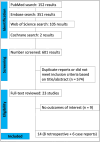Surgical management of retinal detachment and macular holes secondary to ocular toxoplasmosis: a systematic review and meta-analysis
- PMID: 38424638
- PMCID: PMC10903043
- DOI: 10.1186/s40942-024-00540-w
Surgical management of retinal detachment and macular holes secondary to ocular toxoplasmosis: a systematic review and meta-analysis
Abstract
Background: Toxoplasma gondii causes ocular toxoplasmosis (OT), involving inflammation, scarring, and retinal complications. The OT complications were retinal detachment (RD), and retinal breakage (RB). Surgical interventions like scleral buckling (SB) and vitrectomy are common. Limited understanding exists of the safety and efficacy of surgical management of RD/RB secondary to OT. Another complication is toxoplasmosis-related macular holes (tMH), with sparse evidence on surgical outcomes. This meta-analysis aims to clarify clinical characteristics, and surgical results, and enhance understanding of RD, RB, and MH secondary to OT.
Methods: PubMed, Cochrane, Embase and Web of Science database were queried for retrospective studies, case series and case reports that provided information on RD, RB and MH associated with OT and reported the outcomes of: (1) Retinal reattachment of RD/RB and tMH closure; (2) Best-corrected visual acuity (BCVA) improvement; and (3) Complications. Heterogeneity was examined with I2 statistics. A random-effects model was used for outcomes with high heterogeneity. Statistical analysis was performed using the software R (version 4.2.3, R Foundation for Statistical Computing, Vienna, Austria).
Results: Fourteen final studies, comprising a total of 96 patients were analyzed, 81 with RD or RB and 15 with tMH. Overall, surgical management was associated with several advantages: a high rate of retinal reattachment of RD/RB of 97% (95% Confidence Interval [CI] 92-100%; I2 = 0%), retinal reattachment of just RD of 96% (95% CI 89-100%; I2 = 30%) and tMH closure 97% (95% CI 87-100; I2 = 12%). There were significant differences in BCVA after surgeries in studies of RD/RB (MD 0.60; 95% CI 0.35-0.65; I2 = 20%) and MH (MD 0.67; 95% CI 0.50-0.84; I2 = 0%). The overall complication rate associated with surgical procedures in RD/RB secondary to OT was confirmed to be 25%.
Conclusions: The systematic review and meta-analysis showed that the treatment approaches currently in use are effective, with a remarkable rate of retinal reattachment of RD/RB, tMH closure, and substantial improvements in visual acuity. More randomized, long-term studies on disease and surgical factors can provide valuable insights into their impact on anatomical and visual outcomes.
Keywords: Macular hole; Meta-analysis; Ocular toxoplasmosis; Retinal break; Retinal detachment.
© 2024. The Author(s).
Conflict of interest statement
The authors declare that they have no competing interests.
Figures






References
Publication types
LinkOut - more resources
Full Text Sources
Miscellaneous

